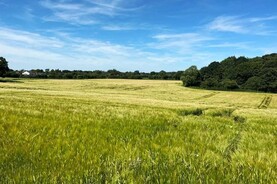Despite the tricky start to breeding regarding a late turnout of stock and some difficult grazing conditions earlier in the month, the breeding season has seen a successful first half. Thirty heifers were synchronised in mid-April with PRIDs, with 10 of these heifers subsequently served with sexed female semen.
‘’These were the 10 strongest heifers of the bunch, and were also showing the strongest heats. The 30 heifers were scanned on Monday, with 18 scanned in-calf, to give a conception rate of 60%, which I am happy with,” said Shaun Diver.
The 12 heifers that were not scanned in-calf have been observed to have been in heat and were re-served three weeks later. Of the 10 heifers served to sexed semen, seven heifers were scanned in-calf to first service.
Of the remaining heifers (11), five heifers were synchronised two weeks ago and served, while the last six heifers will not be served and will be finished on-farm for slaughter. A mix of sexed female and conventional semen from Eldergerry Galahad (EBY) was used on the majority of heifers.
Fifty-five of the 73 cows selected for breeding have now been served in the first four weeks of breeding. Shaun is witnessing a low repeat rate in cows, even with the inclusion of some sexed semen being targeted on some of the herd’s top cows. He is taking steps to compact the calving in Tullamore for 2025, with 30 June being the targeted end of breeding. To achieve this, the last eight cows to calve, which are all over 30 days calved, have been synchronised with PRIDs.
No stock bull
No sweeper bull is to be used on Tullamore Farm this year, owing to the investment and early success of heat detection collars on the farm. Shaun is happy with how the collars are performing, noting the low initial repeat rate to first service and low labour surrounding heat detection now the collars are in place. The use of the collars has eliminated the requirement for vasectomised or stock bulls, both of which had been used in previous years on-farm.
‘’We’ve been able to use more sexed semen on our best cows now, something we wouldn’t have had the confidence to do in the past, through the use of collars and the SenseHub app,’’ stated Shaun. Discussion on the financials of the investment in collars and the initial scan results of the suckler cow herd will be part of this year’s Tullamore Farm open day, due to take place in July.
First-cut silage and surplus bales
The 53 acres earmarked for first-cut silage will hopefully be pitted at the weekend, weather depending. This crop will be the bulk of the winter feed for the farm, with an additional 30 acres planned for a second cut, with baled grass and the combi crop to supplement winter fodder stocks.
Second-cut ground will receive 2,000-2,500 gallons/acre of slurry, plus three bags of 24-2.5-10/acre.
Shaun has mowed out one paddock of surplus grass that had a yield of 2,200kg DM/ha. Pre-grazing yields are sitting slightly above desired covers at 1,600 kg DM/ha, though Shaun is cautious about closing up more ground, with such a large first cut already taken out.






 This is a subscriber-only article
This is a subscriber-only article










SHARING OPTIONS: